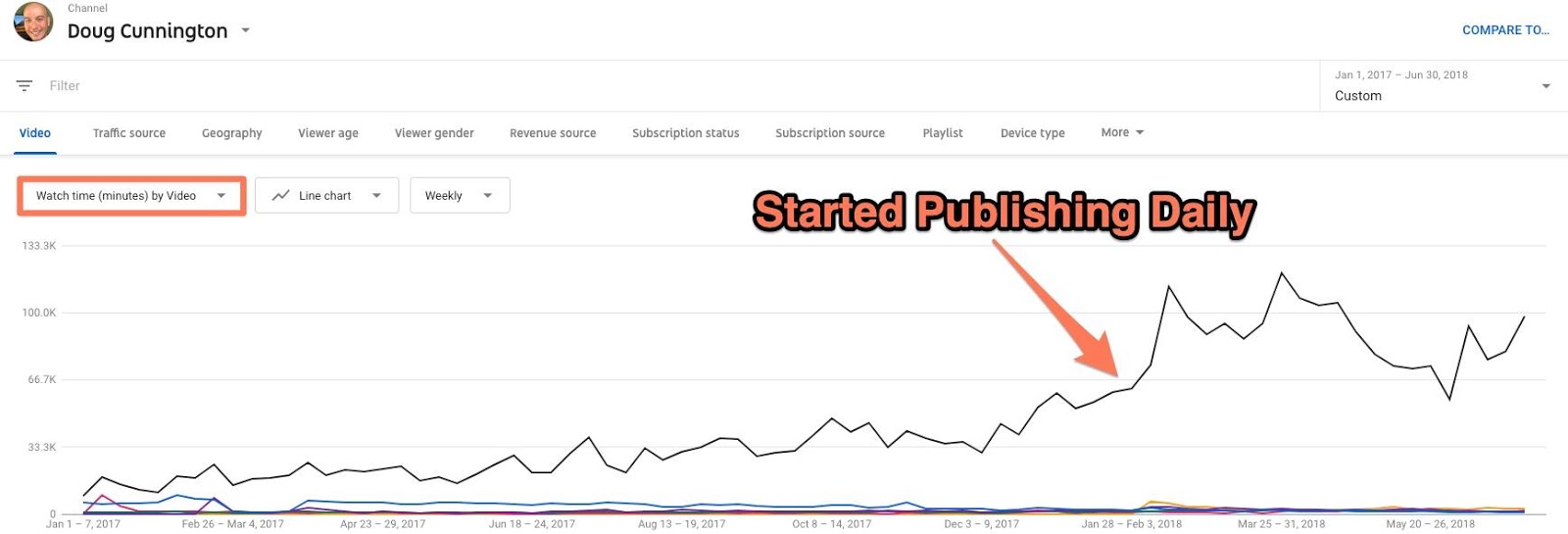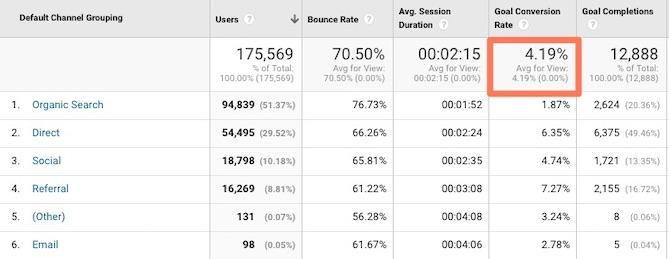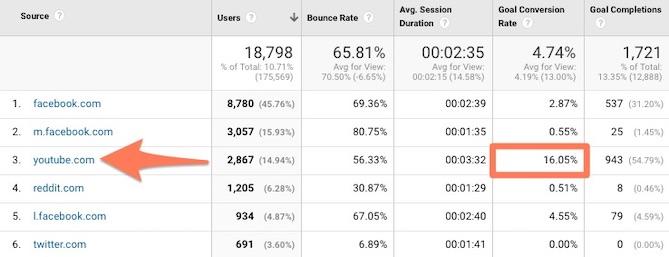How Many Youtube Videos Can I Upload in a Single Day
You can't deny that video is a vital part of whatsoever business's marketing strategy in 2019. In fact, video traffic volition exist a whopping 82% of all global IP traffic past 2022 -- up from 75% percent in 2017. It's clear that web visitors are shifting to video -- Facebook Watch, IGTV, and of course, YouTube take all picked up steam in contempo years. The only question is, are yous going to take reward of that tendency? I saw an opportunity to appoint and grow an audience for my visitor, Niche Site Projection's YouTube channel, and decided to double downward. Literally. I decided to publish ii videos per twenty-four hour period for a month. That might sound like a lofty goal -- peculiarly every bit a squad of one -- but I developed a workflow to do it without stressing out, using the help of two part-time Virtual Assistants (VAs). The results exceeded my expectations for YouTube metrics. Compared to the previous month (when we were publishing once a day): There was also a clear ROI, which I'll explicate later. In this post, I'll talk over: But beginning, a quick groundwork on who I am: I'thousand a Project Management Professional person (PMP) and worked as a corporate management consultant and project director for 10 years. When I got laid off, I decided to plow my side hustle of Amazon Affiliate marketing and SEO into a full-time gig, and that's what I practise at Niche Site Project. Kickoff things first, yous accept to understand why you're doing a project. I noticed that traffic from my YouTube channel converted to electronic mail subscribers at four times the rate of any other source. Traffic from all sources convert at an average of 4.19%. YouTube traffic, on the other hand, converted at nigh 16%. My business is dependent on electronic mail listing growth, so it was a no brainer to put more fourth dimension into YouTube. Pro Tip: If you're trying to get your boss to let you work on a project idea, data makes it easier for her to say yes. If yous don't have disarming information yet, develop assumptions that you tin exam on a small scale start. You'll want to outline your goals so you know how yous're doing during the project, and if you accomplished what y'all intended in one case yous finish. My ultimate goal was to abound the email list, simply I knew a few metrics that would be able to guide me forth the fashion. YouTube analytics are very good for creators, so they'd exist perfect equally Central Performance Indicators (KPIs) along the way. I wanted to improve the following KPIs on YouTube: You'll find I didn't specifically note "abound my email list". Based on the data from the previous 24 months, I already knew that YouTube traffic was converting well for my email listing (4X more than than other traffic). By focusing on growth on YouTube, I knew it would help grow the Niche Site Project audience base of operations. So, over fourth dimension, YouTube growth would be beneficial. All but the last goal are quantifiable data points. The video quality is a perception and thus subjective, only if the quality is proficient, the other three metrics will go up. Plus, if you work on something a lot in a dedicated way with the intent to meliorate, at that place'southward a skilful chance yous'll do just that. This was my arroyo: This process is not a pure project management implementation that you'd meet at the corporate level. It is, still, a model that works well for an individual or small team. I've dabbled with YouTube for a few years. In 2017, I started publishing more videos on a regular basis. At the aforementioned time, I was watching a lot more YouTube, since my gym had dandy wifi. I noticed the YouTubers I watched would typically do a calendar month of daily publishing, and and then review the growth. In the few examples that I studied, I saw they grew their channels a lot. I thought about doing the same thing... and figured, well, why not double information technology? I ordinarily work alone, so I like to review my ideas with other people before starting a project. I talked to a few people who were more experienced nigh doing a content dart on YouTube. I asked for communication and if they saw any pitfalls that I may be missing. I phrased my question in a specific style: "I'chiliad planning on publishing ii videos a day for a month. I've researched and accept seen a few channels that take washed information technology with slap-up results. I have Ten, Y, & Z planned for the process. Do yous have any feel doing a publishing sprint? Practise you lot see any mistakes or flaws in my logic?" In that location were no major issues with the full general plan. Great! Pro Tip: When yous ask people about your idea, be conscientious. Some people imagine whether they could personally do something. If they don't dream big, they might discourage you from even trying. Since I had been publishing YouTube content already, I knew the general process. I as well knew what I liked and disliked. I sketched out this process in about five minutes. Pro Tip: Exercise it past hand and salvage fourth dimension. You could employ a tool or app to design your workflow, but simple is amend. By sketching out the process, it fabricated it easy to identify the tasks that I did Non desire to practise. Some things are better for me to focus on, like: And some things are not fun for me to exercise, like YouTube admin work. That's stuff like: I'm also a pretty tedious video editor. While I bask the process, information technology's not a expert fashion for me to spend my time. Working on things that you're good at is more than enjoyable, of course, but it's unremarkably more productive, too. I didn't desire to be the bottleneck in the process, so I got out of the way. I like tools, apps, and new tech, and so I wanted to have a sophisticated project management solution. I wanted the process to exist automatic and optimized right from the start. I'll come back to this in the lessons learned section after, simply for now, know that: The process helps ascertain the squad. I'g a one-person store, so occasionally, I hire VAs for advert hoc assignments. I was already working with two VAs for YouTube over the previous few months, so it was easy to fold them into this bigger projection. Hither was the team: It was a lean squad, and I got rid of the tasks that I was bad at or simply didn't like. Pro Tip: Before diving into such a big project, check with your Video Editor and YouTube Banana to make sure they're able to practise some extra work during the sprint. When I first hired the Video Editor, it took a little time for me to observe the correct person for my squad. I hired three editors for paid trial gigs to come across how nosotros worked together, and fabricated sure they didn't miss deadlines. I suggest hiring for paid jobs and existent piece of work with deliverables that tin can exist used. It's hard to interview and actually determine if someone can do the job -- completing existent piece of work is the just mode to know. The team had been working together for a few months, slowly tweaking the procedure. Then I was confident in the general process. However, I knew force per unit area testing the system would reveal weaknesses that would need to be refined. Here's how it worked: As you can meet, my process included two handoff points between 3 team members -- simple and straightforward. Pro Tip: If y'all're initially defining the process, so you lot should draft your best guess for the workflow and process. Then, run through the procedure a few times and suit as needed. You will need to adjust, and that's okay. This function is where you do the "real" work! With all my preparation complete, this part was relatively easy. In fact, nigh of the month was far less stressful than normal. It'southward funny to imagine, merely I talked near it with my VAs and it was the same for them. Our goal was very clear during that month: publish a lot of videos. So each twenty-four hour period we all knew exactly what to work on. The goal was to have 50% of the videos done before the xxx days of publishing even started. I fabricated a go-nogo decision the solar day before we started publishing just in case we didn't accept the 50% of the videos done. It was a mad dash of work for well-nigh two weeks, but having half the work done early made the next xxx days much easier. If someone on the team became sick or if something unexpected happened, we would still exist able to meet our goal. Pro Tip: Things rarely go exactly as planned, so add a buffer to your timeline simply in case. In my corporate PM days, it was mutual to add time to the schedule to account for unplanned bug. If yous finished ahead of time, it was great! But, near of the time, in that location was some external factor that acquired a delay. The project schedule could handle it with the buffer time. In project management jargon, this is the "Monitor" phase. For individuals and entrepreneurs, monitoring is skipped often, yet it'southward the most important part. During this phase, you're looking for mistakes, issues, and opportunities to better. People don't usually like looking for mistakes and being self-critical -- even though information technology'southward constructive. Here's why you should practise it even if it's uncomfortable: Hither's how we monitored: We didn't uncover annihilation that was causing major issues. Generally, things were going well, and then the few things we changed were small. Pro Tip: Keep it simple, and create an open up dialogue with your squad. The other huge benefit of a dart-way projection is that you larn fast by doing something daily. My video product skills increased massively in just thirty days. Here are some things that didn't work so well. i. Fancy Tools & Automation I tried to use Google Sheets, Google Calendar, Trello, and Zapier in the beginning to take a sexy calendar view and spreadsheet that was integrated. (Zapier is a groovy app that helps you integrate other apps -- super powerful, merely can exist a bit disruptive.) I burned about three days setting information technology upwardly, which was actually fun, but non worth the effort. Plus, after I tested it, at that place were problems with the integration. Information technology was a mess! I decided to only scrap that idea. Uncomplicated is better. The simplest solution was a spreadsheet -- here's a stripped down sample in Google Sheets. 2. Batching Piece of work I batched a few tasks in the first, like shooting several videos in a row. Except, it turned out, I wasn't batching often enough. I needed to plan things out more intentionally (e.g. outline video ideas, shoot videos). The more work I could batch, the more efficient the whole workflow would exist. With batching I could shoot a week'southward worth of videos in a few hours. It saved a ton of fourth dimension with setup and breakdown of the photographic camera gear and lighting. 3. Pre-Production Tasks I dabbled in video for a piddling while but the content wasn't highly produced -- my videos were usually Live Streams of some kind. Producing video at a fast pace taught me a lot in a very short fourth dimension frame. I never realized how much work goes into a video alee of time. The more preparation you practice, the better your video turns out. Here are some of the pre-production tasks: It seems obvious subsequently the fact, but I was used to doing things on the fly. iv. Uploading the Video to YouTube was Tiresome When the Video Editor finished editing a video, she uploaded the finished video to Google Drive for me to review. If edits were needed, I asked for updates. If the video was terminal and no updates were needed, I downloaded the video and uploaded it. The video files are large, so that takes a few minutes each time. I knew there was some fashion to move files from Google Drive to YouTube, just I was having trouble figuring it out. (More on this later.) Several things went well from the start and a few things improved along the mode since we tried to constantly improve the procedure. 1. Working Alee l% of the videos were shot before I started publishing them. They nonetheless needed to take the post-production work (e.g. thumbnail, YouTube clarification, YouTube tags), but the majority of the work was done. This was a huge mental advantage, every bit the squad started publishing two videos a twenty-four hours. We knew nosotros could do information technology if we were able to practice half of the work alee of time. 2. Using a Simple Content Calendar I find it exciting to integrate apps and automate things -- only information technology's overkill near of the time. I wasted a few days trying to integrate a few apps when Google Sheets would've worked only fine. A spreadsheet didn't have the fancy visual dashboard, but that wasn't a requirement. Pro Tip: Yous don't need to optimize every solution. Simply encounter the requirements to solve the problem. I managed several multimillion-dollar projects for a tier-1 telecom company using a spreadsheet. That was the official PM tool at the company because it was simple and everyone had access to a spreadsheet app. For my content sprint, Google Sheets suited my needs, and no integrations were needed. Always opt for elementary over complex. three. The Workflow The centre of this system was the workflow. I delegated tasks I didn't desire to do (or shouldn't do) to accelerate the procedure. The quality of the resulting piece of work was college, too. Each of the steps in the workflow had kickoff and endpoints. Each endpoint triggered the next action (eastward.g. handoff to the adjacent person). Nosotros didn't need to adjust the main parts of the workflow, but there was one part that could be helped with the right tool. iv. Zapier for Transferring Files From Google Drive to YouTube Google Drive has some interfacing capabilities with YouTube, but I was having trouble getting files moved over apace. Instead of a seamless transfer, I was downloading and uploading large video files each and every time. Information technology took about 30 minutes on average for each video. Yes, a lot of it was but upload/download time, which is largely idle, simply still a waste material of fourth dimension. I started investigating Zaps on Zapier for YouTube and found the right one. When the video editor uploaded a video to a specific binder, Zapier would transfer the file over to YouTube. Boom! This was a huge upgrade to the procedure. At present, once the video editor uploaded a video, the video transferred to YouTube seamlessly. Then, my YouTube Assistant could exercise the mail service-production work. Finally, I did the final cheque earlier publishing. This process is a great example of a sprint of work where I used relevant project management tools from the corporate earth in a existent-life awarding with a small team. I started with a gear up of goals and some assumptions that I tested on a modest scale. The thought of continuous improvement is applied throughout the process by encouraging open dialogue within the squad. We were able to amend along the manner which made united states more efficient. Additionally, I noted what could be improved in the future. For example, I knew that Trello could have been a great solution to aid in the projection direction of video production. I didn't utilise it for this project because the rest of the squad hadn't used Trello earlier. After the sprint was consummate, yet, I introduced Trello to the team. It has some benefits over Google Sheets without adding as well much complication. Conventional wisdom suggests that I should continue publishing more and more than videos to grow. But at that place are other factors to consider besides but growing your watchtime and YouTube subscriber base. And, most importantly, information technology's unsustainable over a long period of time if you have a lean team similar I practise. However, the benefits are long lasting considering the videos tin be watched in the hereafter if the topics are evergreen. And then, the YouTube KPIs may non grow at the same rate after the dart is consummate, but the Niche Site Project audience continues to abound from YouTube. Some other benefit I hadn't considered is being seen equally a YouTube Influencer, then companies and other influencers desire to work with me. ![→ Free Templates: How to Use YouTube for Business [Download Now]](https://no-cache.hubspot.com/cta/default/53/b33cfd44-133a-49e3-a943-086c5679d485.png)

Why Do Information technology?


A Project Direction Approach
1. Define the Projection
two. Review with Peers
3. Outline and Develop the Process

4. Tracking and Managing the Project Status
5. Building the Squad
Near Hiring Freelancers
Workflow and Standard Operating Procedures (SOP)
Executing on the Process
Refining the Process
Lessons Learned
What Didn't Work
What Worked
Takeaways


Originally published Jun 17, 2019 7:00:00 AM, updated June 17 2019
Source: https://blog.hubspot.com/marketing/published-60-youtube-videos-in-30-days
0 Response to "How Many Youtube Videos Can I Upload in a Single Day"
Postar um comentário